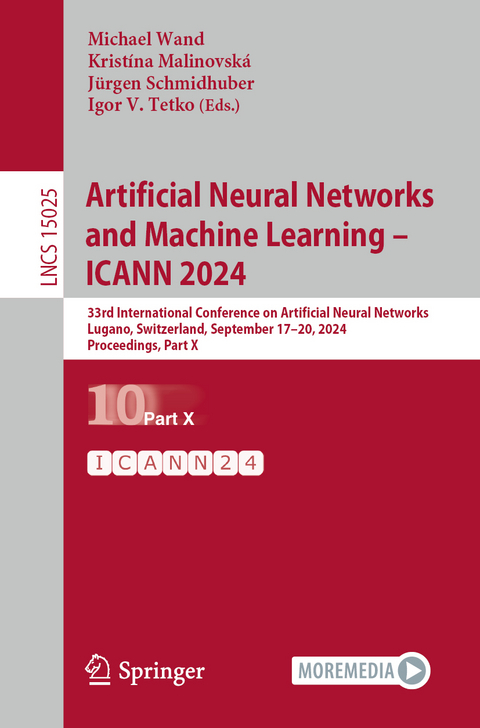
Artificial Neural Networks and Machine Learning – ICANN 2024
Springer International Publishing (Verlag)
978-3-031-72358-2 (ISBN)
The ten-volume set LNCS 15016-15025 constitutes the refereed proceedings of the 33rd International Conference on Artificial Neural Networks and Machine Learning, ICANN 2024, held in Lugano, Switzerland, during September 17-20, 2024.
The 294 full papers and 16 short papers included in these proceedings were carefully reviewed and selected from 764 submissions. The papers cover the following topics:
Part I - theory of neural networks and machine learning; novel methods in machine learning; novel neural architectures; neural architecture search; self-organization; neural processes; novel architectures for computer vision; and fairness in machine learning.
Part II - computer vision: classification; computer vision: object detection; computer vision: security and adversarial attacks; computer vision: image enhancement; and computer vision: 3D methods.
Part III - computer vision: anomaly detection; computer vision: segmentation; computer vision: pose estimation and tracking; computer vision: video processing; computer vision: generative methods; and topics in computer vision.
Part IV - brain-inspired computing; cognitive and computational neuroscience; explainable artificial intelligence; robotics; and reinforcement learning.
Part V - graph neural networks; and large language models.
Part VI - multimodality; federated learning; and time series processing.
Part VII - speech processing; natural language processing; and language modeling.
Part VIII - biosignal processing in medicine and physiology; and medical image processing.
Part IX - human-computer interfaces; recommender systems; environment and climate; city planning; machine learning in engineering and industry; applications in finance; artificial intelligence in education; social network analysis; artificial intelligence and music; and software security.
Part X - workshop: AI in drug discovery; workshop: reservoir computing; special session: accuracy, stability, and robustness in deep neural networks; special session: neurorobotics; and special session: spiking neural networks.
.- Workshop: AI in Drug Discovery.
.- Combinatorial Library Neural Network (CoLiNN) for Combinatorial Library Visualization without Compound Enumeration.
.- De novo Drug Design - Do We Really Want To Be "Original"?
.- Elucidation of Molecular Substructures from Nuclear Magnetic Resonance Spectra using Gradient Boosting.
.- Neural SHAKE: Geometric Constraints in Graph Generative Models.
.- Scaffold Splits Overestimate Virtual Screening Performance.
.- Target-Aware Drug Activity Model: A deep learning approach to virtual HTS.
.- Workshop: Reservoir Computing.
.- Effects of Input Structure and Topology on Input-Driven Functional Connectivity Stability.
.- Non-dissipative Reservoir Computing approaches for time-series classification.
.- Onion Echo State Networks A Preliminary Analysis of Dynamics.
.- Oscillation-driven Reservoir Computing for Long-Term Replication of Chaotic Time Series.
.- Prediction of reaching movements with target information towards trans-humeral prosthesis control using Reservoir Computing and LSTMs.
.- Reducing Reservoir Dimensionality with Phase Space Construction for Simplified Hardware
Implementation.
.- Restricted Reservoirs on Heterogeneous Timescales.
.- Special Session: Accuracy, Stability, and Robustness in Deep Neural Networks.
.- Clean-image Backdoor Attacks.
.- MADE: A Universal Fine-tuning Framework to Enhance Robustness of Machine Reading Comprehension.
.- Robustness of biologically grounded neural networks against image perturbations.
.- Some Comparisons of Linear and Deep ReLU Network Approximation.
.- Unlearnable Examples Detection via Iterative Filtering.
.- Special Session: Neurorobotics.
.- Action recognition system integrating motion and object detection.
.- Active Vision for Physical Robots using the Free Energy Principle.
.- Learning Low-Level Causal Relations using a Simulated Robotic Arm.
.- Modular Reinforcement Learning In Long-Horizon Manipulation Tasks.
.- Robotic Model of the Mirror Neuron System: a Revival.
.- Self-organized attractoring in locomoting animals and robots: an emerging field.
.- Special Session: Spiking Neural Networks.
.- A Multi-modal Spiking Meta-learner With Brain-inspired Task-aware Modulation Scheme.
.- Event-Based Hand Detection on Neuromorphic Hardware Using a Sigma Delta Neural Network.
.- Learning in Recurrent Spiking Neural Networks with Sparse full-FORCE Training.
.- Natively neuromorphic LMU architecture for encoding-free SNN-based HAR on commercial edge devices.
.- Obtaining Optimal Spiking Neural Network in Sequence Learning via CRNN-SNN Conversion.
.- On Reducing Activity with Distillation and Regularization for Energy Ecient Spiking
Neural Networks.
.- Temporal Contrastive Learning for Spiking Neural
Networks.
| Erscheinungsdatum | 20.09.2024 |
|---|---|
| Reihe/Serie | Lecture Notes in Computer Science |
| Zusatzinfo | XL, 438 p. 177 illus., 165 illus. in color. |
| Verlagsort | Cham |
| Sprache | englisch |
| Maße | 155 x 235 mm |
| Themenwelt | Informatik ► Theorie / Studium ► Künstliche Intelligenz / Robotik |
| Schlagworte | Artificial Intelligence • classification • Deep learning • generative models • graph neural networks • Image Processing • Large Language Models • machine learning • Neural networks • Reinforcement Learning • reservoir computing • Robotics • spiking neural networks |
| ISBN-10 | 3-031-72358-9 / 3031723589 |
| ISBN-13 | 978-3-031-72358-2 / 9783031723582 |
| Zustand | Neuware |
| Haben Sie eine Frage zum Produkt? |
aus dem Bereich


